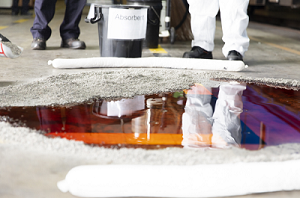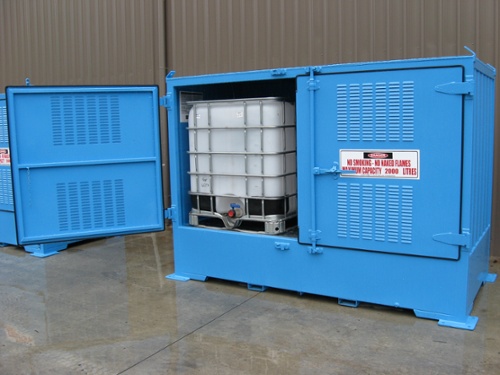Any type of hazardous chemical spill is dangerous, but when you’re working with toxic substances, the risk to people, animals and the environment is magnified. In this blog, we’ll be looking at the precautions you need to take when dealing with a toxic chemical spill or leak in your organisation. We’ll also be explaining some of the measures that you can introduce and monitor to reduce risk of human harm in your workplace.
What Are Division 6.1 Toxic Substances?
Toxic substances are recognised as Division 6.1 Dangerous Goods, within the Class 6: Toxic and Infectious Substances category.
They are defined by the Australian Dangerous Goods Code as substances which can cause serious injury, harm to human health or fatalities if they are inhaled, swallowed or make contact with the skin.
Heath Effects
Clearly, dealing with a leaking container or a spilled drum of toxic substances poses a wide range of risks to human health, from immediate acute effects to long-term chronic effects from repeated exposure.
Health issues from toxic substance exposure may include:
- Short-term exposure – eye irritation, respiratory inflammation, dizziness, nausea, vomiting, diarrhea, fatality
- Repeated exposure – cancer, lung disease, reproductive issues, fatality
Environmental Contamination
We have all heard of incidents of toxic contamination of the environment. This may be from a factory unleashing toxic chemicals into local waterways or an organisation producing large amounts of toxic gases and vapours.
Toxic substances, by their very nature, are chemicals which pose harm to living organisms and the environment. Substances may include mercury, lead, formaldehyde, pesticides or polychlorinated biphenyls (PBCs).
When toxic substances reach the environment, the effects on farm animals, wildlife, marine life, soil and nature can be devastating. If an uncontained spill did occur in your workplace, the toxic chemicals (and any effluent created during the spill and clean-up) can easily escape into the environment, contaminating land or polluting groundwater supplies.
Any type of animal life that inhabits the area will immediately be affected by a toxic substance spill. Chemicals can travel through the food chain and enter the animal through ingestion, inhalation or contact with skin.
IMPORTANT: If your business acquires any type of toxic substance, you should initiate a risk assessment to determine the hazards associated with the chemical. Your risk assessment should consider the potential and impact of a toxic substance spill on your people, property and environment.
Preparing For A Toxic Chemical Spill
Toxic substances, while commonly used in both households and industry, must be handled and stored in a compliant manner to ensure optimum safety for users, the environment and the wider community.
If you carry any type of toxic product, it’s your responsibility under Work Health and Safety Regulations to prevent and manage a chemical spill. Failure to do so can result in severe penalties for non-compliant practices.
It will also put your staff and business at risk due to the severe harm that toxic chemicals cause to people, animals and the environment.
When determining how to best prepare your business for the containment and clean-up of a toxic substance spill, you should refer to the requirements of the Australian Standard. The Standard which relates to Division 6.1 Toxic Substances is AS NZS 4452:1997 – The storage and handling of toxic substances.
Let’s go into further detail about the ways in which you can protect your business from the risks associated with toxic chemical spills.
Identifying Toxic Substances
Preparing for a worst-case scenario, such as a toxic substances spill, is essential for reducing risk in any organisation. Whether it’s a few millilitres of a toxic chemical that’s been spilled on the hands of a worker, or a leaking IBC that’s contaminated a toxic substance store, you must be prepared to quickly and efficiently deal with a leak or spill of any size.

Identifying your chemicals and supplying a compliant spill kit is an essential first step when managing a toxic chemical spill.
In addition to your risk assessment, you should ensure that the following are up-to-date, clearly visible and known to all relevant workers:
- Safety Data Sheets – you are legally required to have your SDS available to staff and emergency services. We recommend storing your SDS in a document box, attached to your safety cabinet or chemical store.
- Chemical labels – the correct labelling of chemical containers, decanting equipment and other transfer equipment is essential when dealing with any type of hazardous substance. Unmarked, empty containers should never be left lying around, as they may be misused by workers who fail to recognise that toxic residue remains in the container.
- Register of hazardous chemicals – the register should be available to anyone using, handling or storing hazardous chemicals. It should accompany the SDS of each hazardous chemical.
- Manifest of hazardous chemicals – a manifest is required when the quantities of toxic or hazardous chemicals exceed the threshold amounts. Your manifest will contain detailed information about the classification, quantity and location of your chemicals.
Spill Containment
As part of your risk assessment, you should have determined your spill containment requirements for your stores of toxic substances (and other dangerous goods).
We recommend the introduction and maintenance of spill containment measures for your handling and storage areas.
Recommendations include:
- Bunded toxic substance storage – make sure that your toxic substance cabinets or outdoor stores are manufactured in full conformance with AS NZS 4452:1997 and that compliant spill containment is provided
- Compliant stacking and loading practices – from minor storage to large package stores, your toxic chemicals should be stacked and loaded in a safe manner that reduces the risk of spillage
- Spill retention for package opening areas – in addition to your bunded storage, you must also provide spill containment when opening toxic substance packages. When your packages are not in use, ensure they are always kept closed
- Suitable chemical containers – when transferring any type of toxic chemical, make sure that the container is suitable for the storage of toxic substances and is labelled accordingly
- Control measures for decanting, pumping and filling – procedures and equipment should be in place to allow for the safe transfer of chemicals
- Spill Clean-up – if a toxic substance does leak or spill, there should be an immediate response by the appropriately trained staff to clean up the spill with a compliant spill kit. Any waste must be disposed of in compliance with AS NZS 4452:1997
- Housekeeping – all stores that house Class 6.1 substances should be monitored for spills or residue and cleaned-up immediately

You’re legally obliged to provide adequate spill containment for the areas in your business that store or handle toxic substances.
Ventilation
In the event of a chemical leak or spill, your workers will be exposed to high concentrations of toxic vapours. As we’ve mentioned earlier in the blog, toxic substances can enter the body through the respiratory system causing acute and chronic health effects from nausea and dizziness to lung disease and fatality.
When dealing with a toxic substance spill, you must ensure that natural and/or mechanical ventilation systems are adequately dispersing the concentrated vapours.
If the spill has resulted in a high concentration of toxic vapours, you should action your Emergency Evacuation Plan and notify emergency services of the situation.
IMPORTANT: Self-contained breathing apparatus (complying with AS.NZS 1716) may be used when cleaning up a toxic substance spill. All protective equipment must be kept in designated, well-identified areas — ready for use by staff. After the spill clean-up, the PPE must be decontaminated to remove toxic chemical residue, before being laundered.
Cleaning Up A Toxic Substance Spill
When a spill occurs in your workplace, you should immediately action your Spill Response Plan. Ensure that the relevant staff (or emergency services) are notified of the spill and that access to the area is prohibited to everyone other than authorised personnel.
Using your chemical spill kit, you must follow your Spill Response Plan and tend to the following:
- Put on the appropriate PPE including protective clothing, shoe covers, gloves, goggles and breathing apparatus
- Stop the toxic substances from spreading further through the work area
- Ensure that the area is well ventilated so that toxic asphyxiation and poisoning does not occur
- Plug any drains to prevent chemicals from contaminating waterways and soil
- Clean-up the spilled chemicals with the absorbents in the chemical spill kit
- Clean down and decontaminate the area with compatible equipment and substances
- Contain the toxic waste in the bags provided in the spill kit
- Dispose of the toxic substance waste in a compliant manner
- Take off, decontaminate, then launder all PPE
- Write up a report of the spill incident
Reducing Toxic Chemical Risk
While every Australian business is obligated to prevent chemical spills, it’s equally as important to be fully equipped and prepared to deal with spillage. As we’ve outlined in this blog, there are a range of safety considerations that you should understand if your business carries any type or quantity of Class 6 Toxic Substances.
If you’d like to find out more about reducing risk in your organisation, we invite you to access our free eBook. How To Manage The Risk Of Hazardous Chemicals In The Workplace will introduce you to our 4-step risk control methodology, which will help you minimise the likelihood and impact of incidents such as a toxic chemical spill. Grab your copy now by simply clicking on the image below.

Living life by the 4 C’s of marketing – communication, coffee, compliance… and more coffee – Leisa Andersen is Storemasta’s Content Marketing Manager. When she’s not writing, you’ll find her enjoying all the good things in life, including shopping, travel and gluten free donuts.
